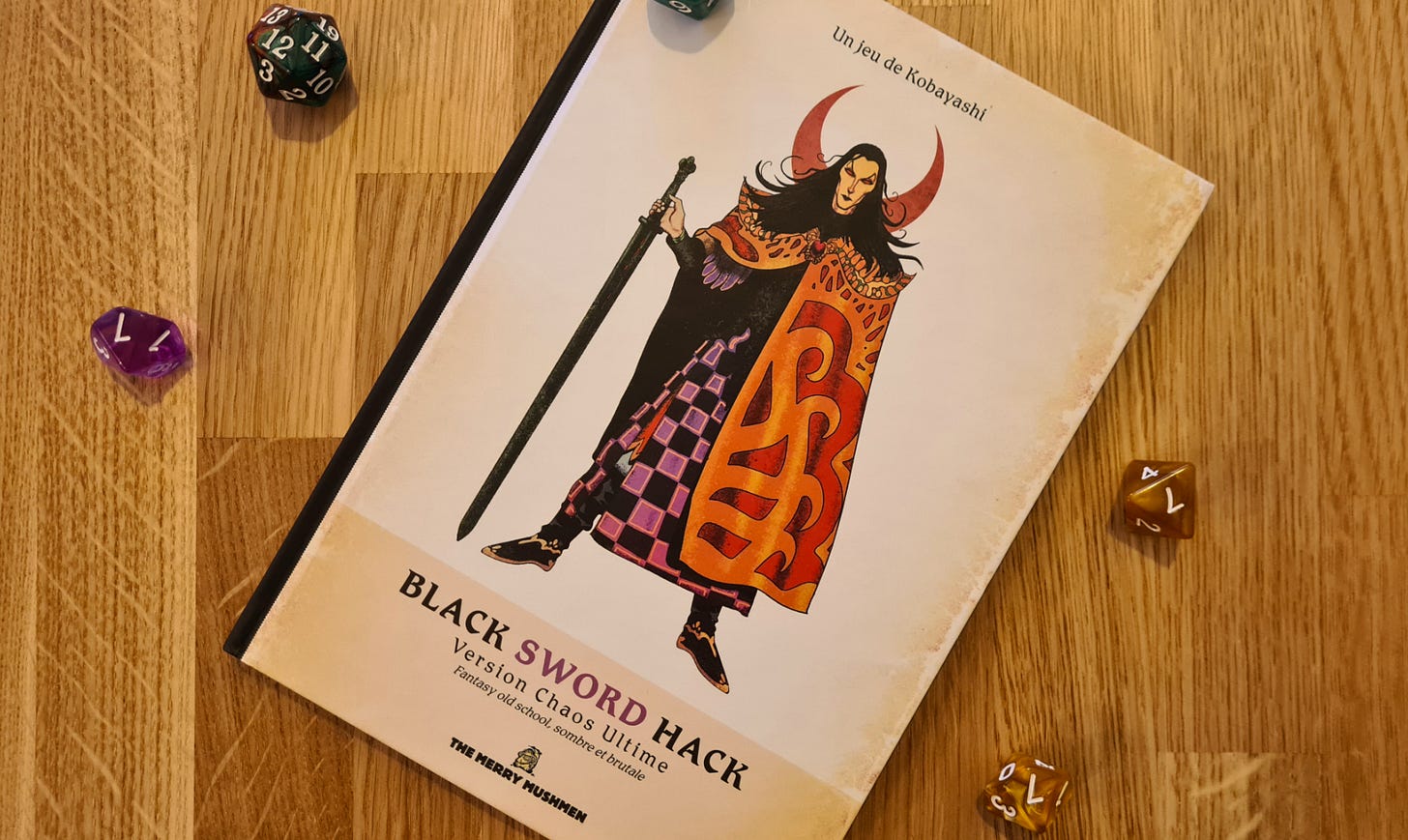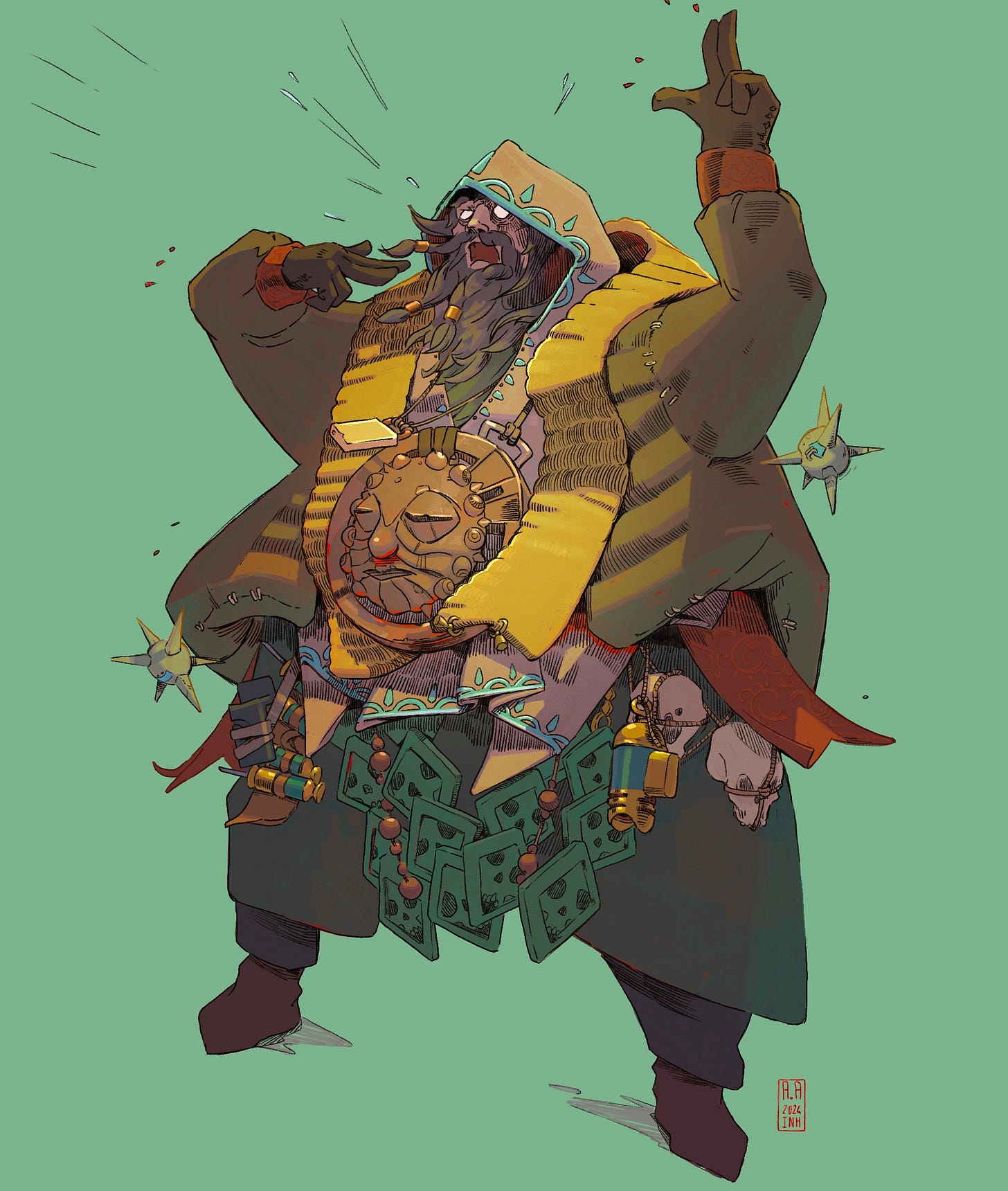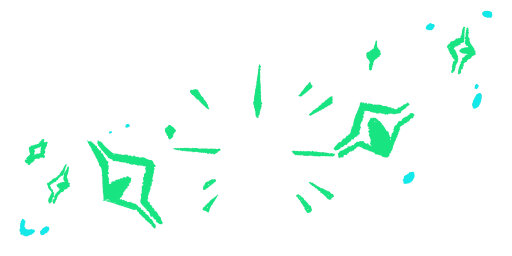Extraction #1 - Black Sword Hack
6/24/2025
Hi cultists, Innoh here! Welcome to my series of short articles focused on game mechanics in TTRPGs.
Throughout the year, I’ll try to publish a series of articles following the same format:
→I’ll select a RPG book that I enjoy.
→I’ll write a brief summary of the game.
→I’ll highlight five mechanics from the system that I find interesting or original.
The goal here is not to explain the entirety of the book’s mechanics but rather to pick five that could be useful for other projects, mixed with others from different systems. Some of these may already be derived from other games, but we will consider them as standalone features.
Additionally, the selected mechanics don’t necessarily have to be core elements of their respective games. The selection might include small but intriguing details or more situational features.
→ Over time, article by article, this series will build a diverse collection of mechanics that can serve as inspiration for your own projects.
For the first entry, let’s check Black Sword Hack!

Summary: Black Sword Hack _ Ultimate Chaos Edition
BSH is a game written by Alexandre "Kobayashi" Jeannette. In 2023, it received an enhanced edition, Ultimate Chaos, published by The Merry Mushmen in a beautiful book filled with illustrations by Goran Gligovic. You can find it HERE.
Mr. Kobayashi has been a prolific creator in the RPG scene for over twenty years (French-speaking friends, check out his blog: Livres de l'ours). With Black Sword Hack, he delivers a Dark Fantasy game set in a grim world filled with decadent civilizations, ruthless barbarians, outlaws, and mercenaries.
The visual inspiration comes straight from pulp fantasy, in the vein of Moorcock, while the mechanical inspiration is drawn from The Black Hack, which lends its name to the game. It employs an efficient roll-under system (the lower the roll, the better), featuring concise yet elegant mechanics, coupled to a traditional stat system (STR, DEX, etc). Most rolls are performed by the players. There are no traditional classes; characters are instead defined by their backgrounds (that you can mix and match) which grant them specific advantages during play. Nevertheless, this is pure OSR at its core: most of the actions players choose to take will have to be found outside their character sheet.
The game is packed with great ideas, but here are five that I particularly enjoyed.
1) The obvious choice: the Doom Die
The Doom Die is a central mechanic of Black Sword Hack, influencing not only the characters’ typical dungeoning actions but also more extraordinary events, such as magic, primal powers, or even twists of fate like critical failures.
This mechanic is based on the Usage Die principle (which is found in The Black Hack). The player starts with an initial die (e.g., a d10). Whenever required, they roll it. On a result of 1 or 2, the die degrades to the next lower step (our d10 becomes a d8).
Over the course of a session, the Doom Die "wears down". Once it reaches a d4 and is depleted, the player can no longer use any actions tied to it. Worse yet, they become Doomed, suffering disadvantages on most actions.
In essence, this die represents the character’s stamina and ability to perform extraordinary feats, such as:
-
Using the same action twice in a fight (two attacks!!)
-
Adding an effect to an attack (sweep, bleeding, etc.)
-
Making a difficult ability check easier
-
Activating powerful talents (e.g., summoning a demonic power)
-
Suffering the effects of a critical failure
The Doom Die is a double-edged sword, introducing a resource management aspect for the player. Once Doomed, the character suffers various penalties for the rest of the day, like disadvantage on the majority of their ability checks.
This die truly enables players to push their characters beyond normal limits, hence a driver of dramatic moments and peripeteias. It recharges after a long rest, ensuring its use is not overly restrictive, making it a core tool of the game.
Personal Note: I wonder if the Doom Die could be combined with HP, creating a single resource that reflects a character’s “Plot Armor”, their ability to dodge injuries, take risks, and defy fate.
2) The threat level: a global combat modifier
Each enemy is assigned a Level, which represents its power (for the moment, nothing particularly original). But, unlike other systems, this number has a real purpose. Every roll related to that enemy is influenced by this level: you apply the difference between your level and the enemy’s level to your roll, making combat harder when facing significantly stronger foes.
Example**:** I want to strike an Angel, a kind of terrifying statue. This creature is level 6, while I’m only level 2. I must add +4 to my Strength roll, making it harder to succeed (yep, remember we’re playing a roll-under game). This modifier also applies to defense rolls or any other checks against the monster.
This mechanic brings several advantages:
-
Simplicity: this is the only stat displayed on a monster info (and HP, ofc). Creatures are much more easy to use from the GM perspective.
-
Streamlined Enemy Stats: it provides the same functionality as traditional stat blocks but in a much faster way. (Do we really need to know that an ochre jelly has -2 to Intelligence checks or that a bandit has more Dexterity than Strength?)
-
Intuitive for Players: a higher-level monster is naturally harder to hit and its attacks tougher to evade, making this system easy to grasp, especially for new players.
This system makes designing foes incredibly simple, especially since Mr. Kobayashi provides a straightforward scale for balancing monsters.
Let’s create one on the spot:
Raving Prophet

-
Level: 3 / HP: 15
-
Hidden Ritual Dagger (DEX): 4 damage, the prophet regains 2 HP.
-
Endless Vociferations (CHA): All affected characters must roll their Doom Die.
-
Mindbreaker (CHA): Warps the target’s mind. 6 damage.
Boom, done in two minutes! The stats in parentheses indicate which ability check is required to resist or avoid the attack.
I also post drawings on Cara and Bluesky btw: Cara or Bluesky
3) Magic as an additional gift for characters
In Black Sword Hack, there are no classes. This means there are no characters specifically dedicated to magic. Instead, characters are defined by their backgrounds (e.g., Raider, Scout, Surgeon), which can be combined in any way. Supernatural powers are simply another type of background (Warlock, Shaman, Dark Knowledge,…).
For example, a character could be a Legionnaire, Sophist, and Warlock, gaining the following bonuses:
-
Legionnaire: You are used to fighting in formation. Three times per day, a nearby ally can reroll a failed dodge, parry, or attack roll.
-
Sophist: You can make people believe an obvious lie if you succeed on a CHA test.
-
Warlock: You have made a pact with two demons, granting you supernatural powers.
(well… from a roleplaying perspective, I have no idea how to embody such a character!)
This background system allows for different types of magic to coexist and intertwine, all accessible to any character. This includes raw magic, spirit magic, demonic powers, fae gifts, or even the creation of wonders.
It should be noted that, regarding game balance, magical backgrounds are not game-breaking.
-
Their use often consumes resources (like the Doom Die).
-
Many come with harsh consequences on failure.
-
Magic effects function more like tools than weapons, enabling creative and unexpected solutions rather than sheer destructive power.
4) Contact, Close, Distant and Far: movement abstraction and distance management
I've always found it difficult to come up with a movement system that feels fair, is easy to use in combat, and supports Theater of the Mind play. The metric/ft system, as still used in Dungeons & Dragons, is highly impractical without a grid or Virtual Tabletop.
Many games offer their own solutions, and the approach in Black Sword Hack is particularly interesting.
Distances are divided into broad categories: Contact, Close (~10 meters / ~30 feet), Distant (~20 meters / ~65 feet), and Far (beyond that). Moving from one range to another costs an action.
Here's a quick scenario to illustrate how it works:
My target, an archer, stands about 20 meters ahead on a small embankment by the road. He is Distant from me. I spend my first action to rush toward him, bringing me Close. I decide to move again on my second action (forcing me to roll my Doom Die, since I’m repeating the same action), and I reach Contact. Next turn, I’m cutting him down!
This system works just as well for reaching static locations, like a chest, a closing magic portal, or any other point of interest. Personally, I find this level of abstraction clear and intuitive, perfectly suited for Theater of the Mind play. Each player can visualize the scene in their own way.
It also helps avoid a common problem in grid-based movement systems: getting stuck one meter away from an enemy due to rigid movement rules, creating bizarre situations where two characters are practically face to face yet unable to interact. In Black Sword Hack, being Close doesn’t mean you’re already in melee range—you’re still eyeing each other warily, making the abstraction much more natural.
5) A detail: runic weapons with damage based on different stats
Here, we’re talking more about a gameplay detail rather than a core feature of Black Sword Hack. However, as mentioned earlier, I intended to select mechanics that function at different levels of gameplay: global (the game’s intention), macro (actions and core game loop), and micro (situational rules).
Runic weapons are magical items, coveted for their ability to deal damage based on one of the character’s stats, whether it’s Strength, Dexterity, Constitution, Intelligence, Wisdom, or Charisma. The mechanic is simple: the weapon deals damage equal to the relevant stat. For example, the Mace of Saint-Celmis could use Wisdom. If you have 14 Wisdom, it deals 14 damage.
In addition to this damage mechanic, there are other details and effects, randomly determined, such as the weapon’s material or an effect triggered upon an enemy’s death (e.g., drinking their soul, turning their body to ash, etc.).
First, this mechanic is interesting because it immediately introduces diversity. For instance, a character with high Charisma can also wield a weapon effectively. This gives value to stats that are often overlooked by players (CON, WIS, CHA).
Secondly, it’s a visually striking mechanic. The stat/weapon connection creates a clear representation of the weapon. A whip based on Charisma could be sleek and elegant, while a mace tied to Constitution is heavy, rustic, and indestructible.
This mechanic serves narrative purposes, which is a core principle of TTRPGs, isn’t it?
— There are MANY more cool ideas in Black Sword Hack, and I encourage you to check out the book (HERE), it’s great! I’ve limited the number of mechanics to 5 to keep the article digestible and avoid an unnecessary deep dive into each system.
Did you particularly enjoy other mechanics from the game?
For the next article, I’ll probably talk about Shadowdark, or perhaps Mörk Borg. Anyway, something classic!
Have a great day! The Cult of Magest is watching you!



